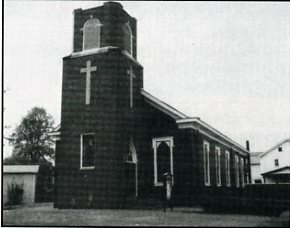
St. Peter's Evangelical Lutheran Church was built in 1832
by the New Philadelphia Society.
Click Here to Return to Milestones

In 1832, a group broke away from the Harmony
Society at Economy and purchased Phillipsburg (now Monaca). Included
with the land were twenty abandoned buildings, which had been
the Stephen Phillips boat yard and worker housing. The frame structures
would shelter them while they built a proper town. They meant
it to rival Economy, widely hailed for excellence in architecture,
culture, and a fine educational system for adults as well as children.
In Phillipsburg, their first order of business was to incorporate
themselves as the New Philadelphia Society. Next they built a
house of worship (which stands today as St. Peters Church). Then
they opened the school. Education was an extension of the church,
and the first classes met in that building. Money had no place
in the communal society; everyone contributed work, and everyone
shared in the benefits. Education was financed by the community
treasury.
These ex-Harmonists were staunchly German in language and culture.
They had lofty ideals, and made education a high priority. Their
academy would have been patterned after the one at Economy, bearing
little resemblance to the stark 3-R agenda of American schools
of the period. Standards of teaching were European, influenced
particularly by Martin Luther and the Swiss philosopher, Johann
Pestalozzi. Emphasis was on moral instruction, vocational training,
languages, the sciences, and the arts.
The architect of pedagogy at Phillipsburg would have been Dr.
Johann Christoph Mueller, who had been Director of Education in
the Harmony Society for twenty-seven years. Probably the first
schoolmaster was another seceder, Hubert Delhaas. The duties of
superintendent were assumed by the pastor as part of his church
assignment.
Sadly, the utopian community did not last. The brotherhood dissolved
just eighteen months after its founding. The model of ideal education
collapsed as most people left town. Among those departing were
Mueller and Delhaas, champions of the European-based curriculum.
New people settled in Phillipsburg, including English, French,
and other Germans. Their values were geared more toward daily
survival. Formal instruction was expensive and not a priority
with them. For a while students attended classes on a private
pay basis.
Eventually local public money was collected for teacher salaries,
books, supplies, and maintenance. It was supplemented by an appropriation
from the state. But the tax payers were not generous. When allotted
funds were spent, instruction was suspended until the following
autumn. For a while the school year ranged from three to five
months, a month consisting of "24 full days - or if Saturday
afternoon for 26 days." In 1855 the Commonwealth threatened
to withdraw its supplement if school were not held for four months.
In 1840 a lot near the church was leased from the congregation,
and the first school house was built of frame. The newly incorporated
borough was growing quickly. Soon the building could not house
all the students. Yet the voters refused to raise the taxes. In
1847, they turned down a bill to purchase part of the old woolen
mill site and construct a new building. Two months later they
defeated a proposal to use surplus treasury money to enlarge the
existing facility. As a stopgap measure, a partition was constructed
across the old classroom, and space was rented in two stores.
Three years later, in 1850, a second school was built on the same
lot. The new structure was of brick and measured 30 x 20 x 10
feet high. It housed the younger pupils, who were instructed in
German. Classes for older children, taught in English, were held
in the older building. Eventually the space between the two buildings
was fashioned into an anteroom and was used to store coal.
The surrounding township of Moon (now Center) was growing as well.
In 1847, those citizens petitioned to merge with the Phillipsburg
School District. The measure was defeated, but two years later
the board accepted three students as soon as tuition could be
collected.
In 1847, the two teachers were each paid $18 per month, of which
a dollar had to be returned to rent their spaces. By the next
year, salaries had risen to $22 per month, with a stipulation:
the school masters were to be responsible for all damages done
to the school house or other property while students were in their
charge, and were to bar throwing stones and other missiles, using
clubs, and fighting. Discipline seems to have been a chronic problem.
In 1854 a student was brought before the board for rebellious
and irresponsible behavior; he was suspended for a month. There
was discussion about abolishing recess, instead dismissing the
younger students a half hour earlier. At last the board voted
to exclude offending students for one or two days, if all other
measures had failed.
Textbooks were those popular in America at the time. In 1852,
the board adopted Sanders' Spelling Book and the "Straus
series from the first reader." In 1855, the Straus editions
were replaced by the McGuffey Eclectic Readers. The board also
approved the use of Greensleeves' arithmetic and Fletcher's geography.
Sanders' spelling book was retained.
By this time, a generation of students had been schooled in Phillipsburg,
and education had been revolutionized. Classes were no longer
under the aegis of the church. The source of funding had evolved
from communal till to private pay, to levied taxes and state appropriation.
Schools were populated with students who'd never heard of the
New Philadelphia Society. The curriculum had evolved from European
to American, and was keeping pace with the times.
Consequent generations have witnessed further reshaping of education.
Time and again, school buildings have been replaced, and curriculum
has been revised. But no peer group has experienced change as
great as the first generation of scholars in Phillipsburg.